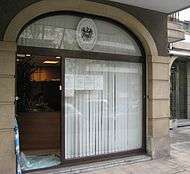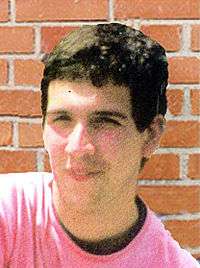2008 Getxo bombing
| 2008 Getxo bombing | |
|---|---|
| Part of the Basque conflict | |
 Ertzaintza officers in front of a damaged building | |
| Location | Getxo, Biscay, Spain |
| Date |
19 May 2008 00:50 (UTC+1) |
Attack type | van bomb |
| Deaths | 0 |
Non-fatal injuries | 0 |
| Perpetrators | ETA |
The 2008 Getxo bombing occurred on 19 May 2008, when a van bomb went off outside a boat club in the town of Getxo, Biscay in the Basque Country, Spain. The attack caused serious damage to the club, as well as nearby buildings and structures. No one was killed or injured after a warning call from the Basque separatist organisation ETA. On 31 May, the organisation claimed responsibility for the bombing.[1]
Five days before the attack, another ETA car bomb in a Civil Guard barracks in Legutiano, Álava killed a Civil Guard member and injured four. Both attacks were blamed on the Biscay cell of ETA led by Arkaitz Goikoetxea Basabe, which was most active after the end of the 2006 ceasefire, and was responsible for several attacks in the region during 2007 and 2008. Most of the cell members, as well as the participants in the attack, were arrested in July 2008.[2]
The attack came hours before a meeting by Spanish Primer Minister José Luis Rodríguez Zapatero and Basque lehendakari Juan José Ibarretxe to discuss the Basque Conflict. On the same day of the attack, a memorial service for victims of terrorism was held in San Sebastián.[3]
Background
Getxo, a wealthy seaside suburb near the city of Bilbao, has been the location of several ETA attacks during the Basque conflict, with most of the attacks being carried out in the Las Arenas neighbourhood, home to many businessmen and entrepreneurs.[4] Three civil guards were killed in an ambush in Las Arenas in October 1978.[5] In 2000, a car bomb injured seven on June 25, and four people were wounded in another car bomb attack on July 24. On January 22, 2001, Ertzaintza members deactivated a car bomb and judge Jose Maria Lidón Corbi was shot dead on November 7. On April 20, 2002 a car bomb exploded in front of the house of a businessman, who had been kidnapped in 1996. A bomb exploded inside a hotel on June 23, 2003, while another car bomb went off on January 18, 2005, injuring one.[6] On November 11, 2007, two booby trap bombs failed to explode in front of a courthouse.[4] The same boat club had already been attacked by bombs on March 12, 1969 and on December 30, 1971. On November 26, 1973 six ETA members set fire to the club.[7]
2008 was ETA's deadliest year since the end of the 2006 ceasefire.[8] In mid 2006, the organisation declared a ceasefire, and conversations between Batasuna, ETA and the Basque and Spanish governments started. Peace talks ended in December, when ETA broke the truce with a massive car bomb at Madrid-Barajas Airport. ETA officially ended the ceasefire in 2007, and resumed its attacks around Spain. At the same time, dozens of members were arrested by Spanish and French police. Despite that, the organisation did not lose the capacity for carrying out attacks.[2]
Attack
The vehicle, a Citroën Berlingo, the same model used in the Legutiano attack, was stolen in Getxo on the same morning of the attack by a cell formed by Arkaitz Goikoetxea Basabe and fellow ETA member Aitor Artetxe Rodríguez.[9][10] The car was the property of a company owned by a former member of ETA, Xabier Izko de la Iglesia, who had been sentenced in the 1970 Burgos trial. The car was then loaded with 60 kg of ammonal, a type of explosive usually used by ETA.[10] The car also contained shrapnel shell in order to increase the destructive power. The explosive device had been obtained in the town of Ezcaray, La Rioja and was similar to an abandoned bomb found in Getxo on January 31, 2008.[9][11]

At 23:55, Goikoetxea phoned the DYA headquarters, a Basque roadside assistance association, in Bilbao on behalf of ETA, to alert them that a car bomb would go off in Getxo: "Listen carefully, I'm calling on behalf of ETA. In one hour, a van bomb is going to explode in the seafront walk, next to the boat club of Getxo. Do you understand? Freedom for the Basque Country. Long live ETA".[9] According to reports, the warning call was made from a telephone box located 500 meters from the boat club.[12] A few minutes later, a worker from the club spotted two hooded people, abandoning a vehicle in the middle of the road. Once Ertzaintza officers spotted the vehicle, the area was cordoned off and people evacuated from nearby houses. A family reported to have not been warned of the detonation.[11]
At 00:50, ten minutes before the time the caller had given, the device went off.[3] The detonation tore a hole in the ground and caused considerable damage to the club. Several floors of the building were ripped open and it suffered serious structural damage. Nearby houses and buildings were also affected by the explosion, which was heard in most of the towns around the Estuary of Bilbao.[13] According to the Spanish High Court, 114 people were affected in some way by the attack.[9]
After the attack, Ertzaintza kept the area cordoned off, while looking for other possible bombs. Meanwhile, Goikoetxea headed to Leioa and met Artetxe in a nearby mountain, where they would stay the whole night.[9] By the morning, no other devices had been found and people were able to return to their homes.[13]
Aftermath
Many authorities and politicians condemned the attack. Basque Nationalist Party president Íñigo Urkullu stated that "once again ETA tried to unreasonably become the judge of the Spanish politics" and Partido Popular president Mariano Rajoy gave his support to the government of Spain in its fight against ETA. Most of the political parties also condemned the attack, with Aralar stating that "ETA is an obstacle towards the peace that Euskal Herria (Basque Country) demands".[11]
Arrest

On July 22, 2008, the Civil Guard dismantled the Biscay cell, with the arrest of nine members of ETA, including Goikoetxea. Most of the arrests were made in Bilbao, Getxo and Elorrio, while two other people were held in Fuengirola, Málaga and in Nigran, Pontevedra.The operation, which was led by judge Baltasar Garzón, also ended with the arrest of Gaizka Jareño Ugarriza, Adur Aristegi Aragon, Iñigo Gutierrez, Aitor Kotano Sinde, Libe Agirre Mazaga, Maialen Zuazo y Ana Isabel Prieto Fundarena.[14] Senior members of the cell, such as Jurdan Martitegi or Asier Borrero were not arrested.[15] The cell was going to carry out another car bomb attack in Getxo on July 31 and had plans to attack the Bilbao Exhibition Centre, as well as judge Fernando Grande-Marlaska.[16]
Aitor Artetxe was another cell member on the run until he was arrested in the French town of Gerde, Hautes-Pyrénées on December 8, 2008. On the same operation, head of the military commandos Aitzol Iriondo was also arrested, as well as another senior member of ETA, Eneko Zarrabeitia Salterain.[9][17]
On August 19, 2009, judge Santiago Pedraz prosecuted Goikoetxea and Artetxe for the attack.[9]
See also
References
- ↑ "ETA: «PSOE y PNV no ofrecen más que un oscuro futuro lleno de límites»". gara.net (in Spanish). May 31, 2008. Retrieved 2010-12-06.
- 1 2 "Nine ETA bombing suspects arrested". articles.cnn.com. July 22, 2008. Retrieved 2010-12-06.
- 1 2 "Car bomb explodes in Spanish Basque area". gmanews.tv. May 19, 2008. Retrieved 2010-12-06.
- 1 2 "Las Arenas, un objetivo habitual de las bombas de ETA". elcorreo.com (in Spanish). May 19, 2008. Retrieved 2010-12-06.
- ↑ Otro criminal atentado en Bilbao, La Vanguardia, 24 October 1978, p13
- ↑ "Atentados de ETA desde la ruptura de la última tregua". elcorreo.com (in Spanish). March 22, 2006. Retrieved 2010-12-06.
- ↑ "Un incendio provocado por ETA en 1973 obligó a demoler el Club Marítimo". ideal.es/granada (in Spanish). May 19, 2008. Retrieved 2010-12-06.
- ↑ "Doce muertos, el sangriento balance entre las dos treguas trampa de ETA". abc.es (in Spanish). November 21, 2010. Archived from the original on 26 November 2010. Retrieved 2010-12-06.
- 1 2 3 4 5 6 7 "Goikoetxea y Artetxe, procesados por atentar contra el club marítimo de Getxo". elmundo.es (in Spanish). August 19, 2009. Retrieved 2010-12-06.
- 1 2 "La furgoneta bomba utilizada en el atentado de Getxo fue robada de la empresa de un miembro histórico de ETA". ideal.es/granada (in Spanish). May 20, 2008. Retrieved 2010-12-06.
- 1 2 3 "ETA cargó la furgoneta bomba de Getxo con 60 kilos de goma-2". rtve.es/noticias (in Spanish). May 19, 2008. Archived from the original on 28 November 2010. Retrieved 2010-12-06.
- ↑ "ETA avisó del atentado de Getxo desde una cabina situada a 500 metros del club marítimo". rtve.es/noticias (in Spanish). May 20, 2008. Archived from the original on 25 November 2010. Retrieved 2010-12-06.
- 1 2 "Explota una furgoneta-bomba en el paseo marítimo de la localidad vizcaína de Getxo". rtve.es/noticias (in Spanish). May 19, 2008. Archived from the original on 28 November 2010. Retrieved 2010-12-06.
- ↑ "La Guardia Civil desarticula el 'comando Vizcaya' de ETA con nueve detenciones". rtve.es/noticias (in Spanish). July 22, 2008. Archived from the original on 25 November 2010. Retrieved 2010-12-06.
- ↑ "Policía y Ertzaintza intensifican la búsqueda de los etarras huidos para evitar más atentados". diariovasco.com (in Spanish). July 31, 2008. Retrieved 2010-12-06.
- ↑ "Objetivo de ETA: coche bomba el 31 de julio en el barrio de Neguri de Getxo". 20minutos.es (in Spanish). July 24, 2008. Retrieved 2010-12-06.
- ↑ "Detenido en Francia el etarra Aitzol Iriondo, supuesto sucesor de Txeroki". elpais.com (in Spanish). December 8, 2008. Retrieved 2010-12-06.